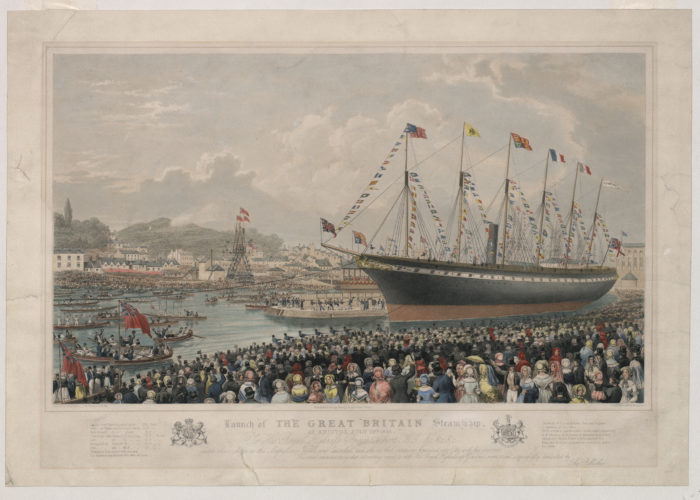Launch of the Great Britain Steamship,1843. Lithograph of a painting by Joseph Walter
Theme: Transporting revolution, Economic and technological revolution, Medicine, science and the people
Isambard Kingdom Brunel’s SS Great Britain is one of Britain’s most important ships. By combining size, power and innovative technology, Brunel revolutionised sea travel and paved the way for modern ship design.
Originally built as a luxury ocean liner, Brunel designed the SS Great Britain to be speedy, sturdy, economical and to carry as many passengers as possible. His genius was in combining innovative ideas and new technologies into the design of one vessel. The ship was made of iron, which was cheaper than wood and more durable on long voyages – especially in rough weather. She was fitted with the most powerful steam engines ever to have been used at sea, together with an exciting new invention – a screw propellor. These combined to give the ship its speed. She was also fitted with sails, which could be used to supplement the engine’s power and save on the cost of fuel.
At the time, a metal ship of that size had never been made before and many believed it wouldn’t float.
When it was launched in 1843, the SS Great Britain was the largest ship afloat. She could carry 360 passengers, 120 crew members, 1,200 tons of cargo and 1,200 tons of coal. At the time, a metal ship of that size had never been made before and many believed it wouldn’t float. But on her maiden voyage, from Liverpool to New York in 1845, she safely crossed the Atlantic in a record fourteen days – half the time of a sailing ship.
This image shows the launch of the SS Great Britain in Bristol on 19 July 1843 by His Royal Highness Prince Albert – Queen Victoria’s husband and one of the most famous celebrities of the day. The event caused great excitement. Schools and shops were closed, the streets were decked with flags and banners, peels of bells rang out and cannons fired. Tens of thousands of people crammed themselves into every space they could find, on the dockside, on small boats, even on the rooves of houses, eager to witness the launch of this extraordinary new ship.
Did you know..?
In today’s money, the final bill for the construction of the SS Great Britain would have been 13½ million pounds.
Use our Classroom resources to investigate this object and the theme of Transport further.
Highlights:
- Using objects, artworks and other sources to find out about the past
- Enquiry: How was transport different in the past?
- Enquiry: A transport revolution?
- Looking closely at images
- Transport pairs
And much more…
Sources & acknowledgements
This object description and its related educational resources were researched and written by our team of historians and education specialists. For further information see the item’s home museum, gallery or archive, listed above.
- Related resources
- Enquiry Questions
-
Did you know..?
In today’s money, the final bill for the construction of the SS Great Britain would have been 13½ million pounds.
-
Education overview
You can access a range of teachers resources related to this object and more on our education page.
Please also see our glossary of terms for more detailed explanations of the terms used.
-
Curatorial info
- Originating Museum: SS Great Britain Trust
- Production Date: 1843
- Creator: Joseph Walter
- Original record
-
Use this image
Image courtesy of the SS Great Britain Trust. Please see their website for the terms of use.
- Rights Holder: SS Great Britain Trust
- License Type: All Rights Reserved
Find it here
This object is in the collection of Brunel’s SS Great Britain



